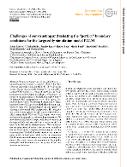Challenges of constructing and selecting the "perfect" boundary conditions for the large-eddy simulation model PALM

Autor
Resler, Jaroslav
Datum vydání
2024Publikováno v
Geoscientific Model DevelopmentRočník / Číslo vydání
17 (7)ISBN / ISSN
ISSN: 1991-959XISBN / ISSN
eISSN: 1991-9603Metadata
Zobrazit celý záznamKolekce
Tato publikace má vydavatelskou verzi s DOI 10.5194/gmd-17-2901-2024
Abstrakt
We present the process of and difficulties in acquiring the proper boundary conditions (BCs) for the state-of-the-art large-eddy simulation (LES)-based PALM model system. We use the mesoscale Weather Research and Forecasting (WRF) model as a source of inputs for the PALM preprocessor and investigate the influence of the mesoscale model on the performance of the PALM model. A total of 16 different WRF configurations were used as a proxy for a multi-model ensemble. We developed a technique for selecting suitable sets of BCs, performed PALM model simulations driven by these BCs, and investigated the consequences of selecting a sub-optimal WRF configuration. The procedure was tested for four episodes in different seasons of the year 2019, during which WRF and PALM outputs were evaluated against the atmospheric radiosounding observations. We show that the PALM model outputs are heavily dependent on the imposed BCs and have different responses at different times of the day and in different seasons. We demonstrate that the main driver of errors is the mesoscale model and that the PALM model is capable of attenuating but not fully correcting them. The PALM model attenuates the impact of errors in BCs in wind speed, while for the air temperature, PALM shows variable behavior with respect to driving conditions. This study stresses the importance of high-quality driving BCs and the complexity of the process of their construction and selection.
Klíčová slova
LES modeling, Urban Climate, Computational Fluid Dynamics
Trvalý odkaz
https://hdl.handle.net/20.500.14178/2967Licence
Licence pro užití plného textu výsledku: Creative Commons Uveďte původ 4.0 International






